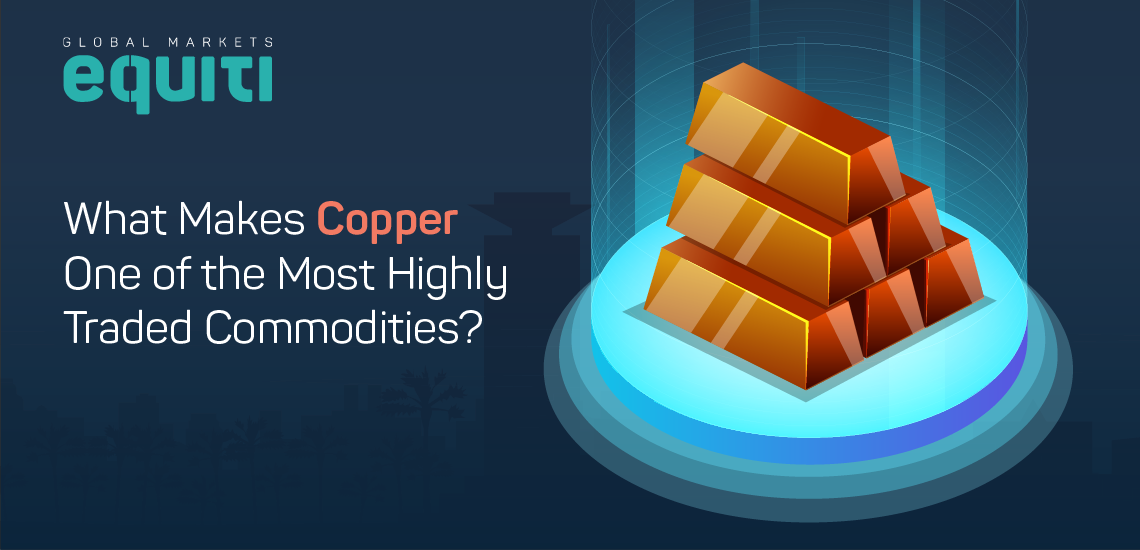The author is an expert in the field of multi-asset trading.
What Makes Copper One of the Most Highly Traded Commodities?

Copper is considered one of the oldest known and traded commodities and has a large bearing on the worldwide economy, but what makes it so? Find out below why copper dominates the commodities market and why many traders are making this metal a part of their trading portfolio.
Copper in a Nutshell
Copper has first been mined and used by humans more than 10,000 years ago and is today one of the most widely-used and versatile metals in the world. Due its significance to the world economy, copper is an internationally traded commodity, and its price is determined by major metals exchanges. Prices on exchanges such as the London Metals Exchange, the New York Commodity Exchange and the Shanghai Futures Exchange are generally affected by the global supply for copper and the demand for it, but occasionally the prices are also influenced by investments and currency exchange rates.
As a metal, copper’s physical properties make it useful in a wide array of applications, most notably for electrical and construction purposes. Copper’s advantages, including its superior electrical conductivity, high corrosion resistance, structural capabilities, and efficient heat transfer, set it apart from competing materials such as aluminum, plastics, stainless steel and fiber optics. However, even when copper prices are high no other material has been able to duplicate or dethrone copper.
The consumption of copper is closely tied to industrial production and construction booms, so demand for it generally follows economic cycles. When the economy is doing well or expanding, the demand, and thus the price, for copper tends to increase, especially when it's paired with limited supply. And the converse is true, a supply glut and limited demand drives the price down. The result is that copper prices can be volatile and cyclical in nature.
Copper as a Commodity
Copper is an essential industrial metal worldwide, and along with energy sources such as oil and integral food stuffs, it is of the most important commodities for global trade and human civilization in general. Copper is used extensively in construction and can be found in wires and circuit boards all around you. And although its physical properties are similar to gold and silver, unlike those two precious metals copper is not viewed as a currency or store of value, so it costs far less.
Copper mining produces the majority of the world supply (with a small fraction from recycled scrap sources), and most of it comes from open and underground mines around the world. Chile is the worldwide leader in overall copper production, and any developments there affect the global supply and price of copper. The total annual supply exceeds 19 million tons globally, and is expected to stay stable for the foreseeable future, with a low probability of major new copper discoveries.
The demand for copper increases as the global economy grows and more countries develop and increase their infrastructure needs. As large and populous countries such as China and India continue to develop at a fast pace, they put a larger demand on an already strained supply. China uses almost half of the world’s copper supply, so any developments in its economy have a big effect on the manufacturing and building industries, and their associated markets.
Trading Copper
You can trade copper just as you trade other commodities like oil and natural gas, and copper prices are closely monitored in the financial markets and often feature in economic and business news. Given its uses in a diverse array of industries, copper price gives a good picture of the overall state of the global economy, especially emerging markets where the needs are greatest.
Commodity traders often view investing in copper as a way of expressing a bullish view on world GDP, given its close ties to the building and industrial sectors of the world economy. By buying copper you’re betting on global growth. Trading copper also provides asset class diversification and can lower your exposure risk to other volatile instruments in your portfolio.
There are several factors that affect the price of copper, including oil prices (copper refining is energy intensive), demand from established markets such as the US (especially the housing market) and emerging markets like China, extraction costs and mining disruptions, and more. Copper prices are commonly quoted in US Dollars, so the strength of the dollar also plays a role.
Copper CFDs
One of the ways of investing in copper is through Contracts for Difference (CFDs), which are derivative instruments that allow traders to speculate on commodity prices. With copper CFDs you can speculate on a rising or falling copper price without actually owning physical copper bullion or shares in mining companies. By trading copper CFDs, you can speculate not just on the metal itself but on industrial growth, the housing market, and supply and demand imbalances that are tied to it.
Stay tuned for a more in-depth look into this special metal and the numerous factors that drive the price of copper. In the meantime, you can open a free demo account to practice trading copper and see the price action for yourself.